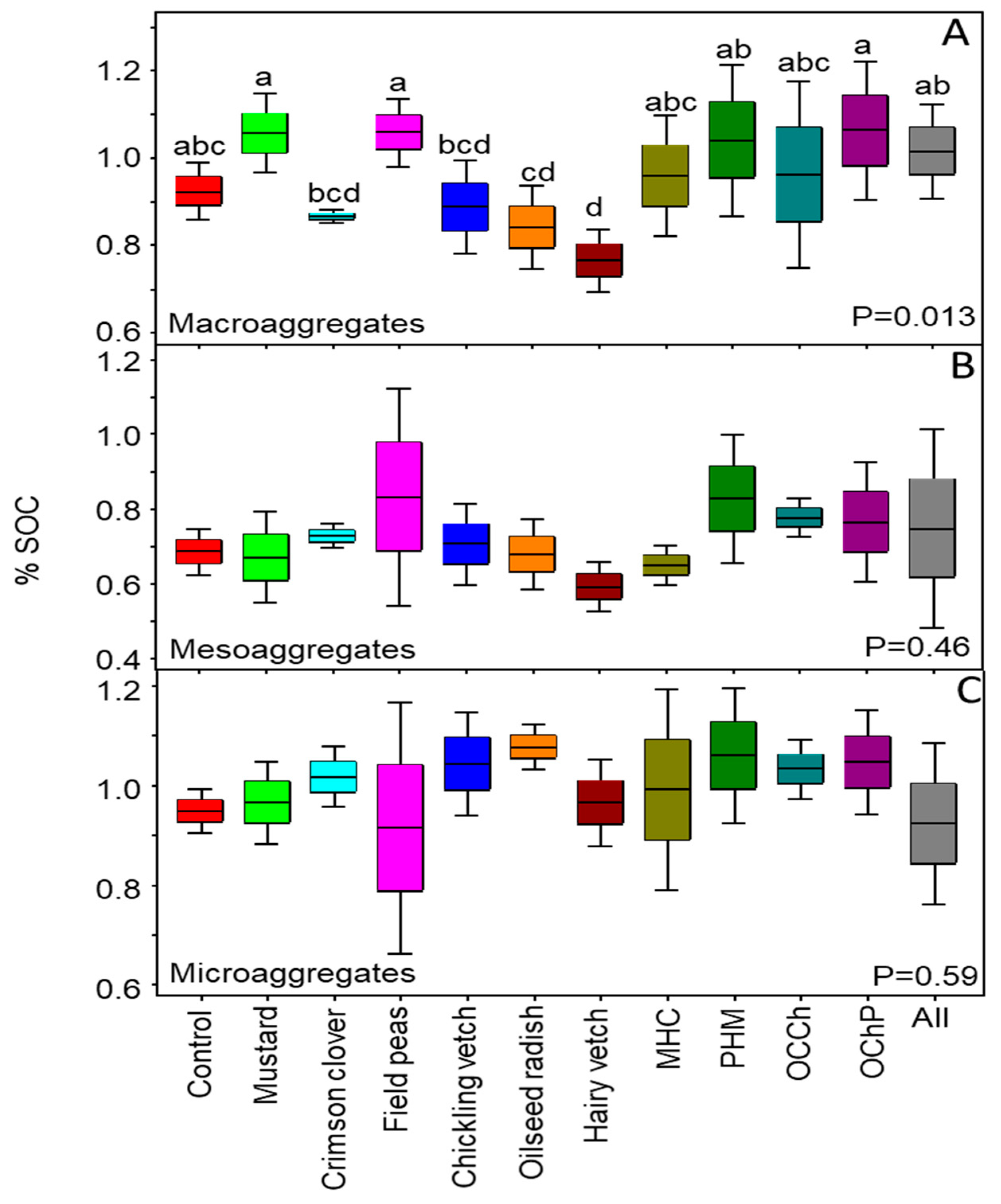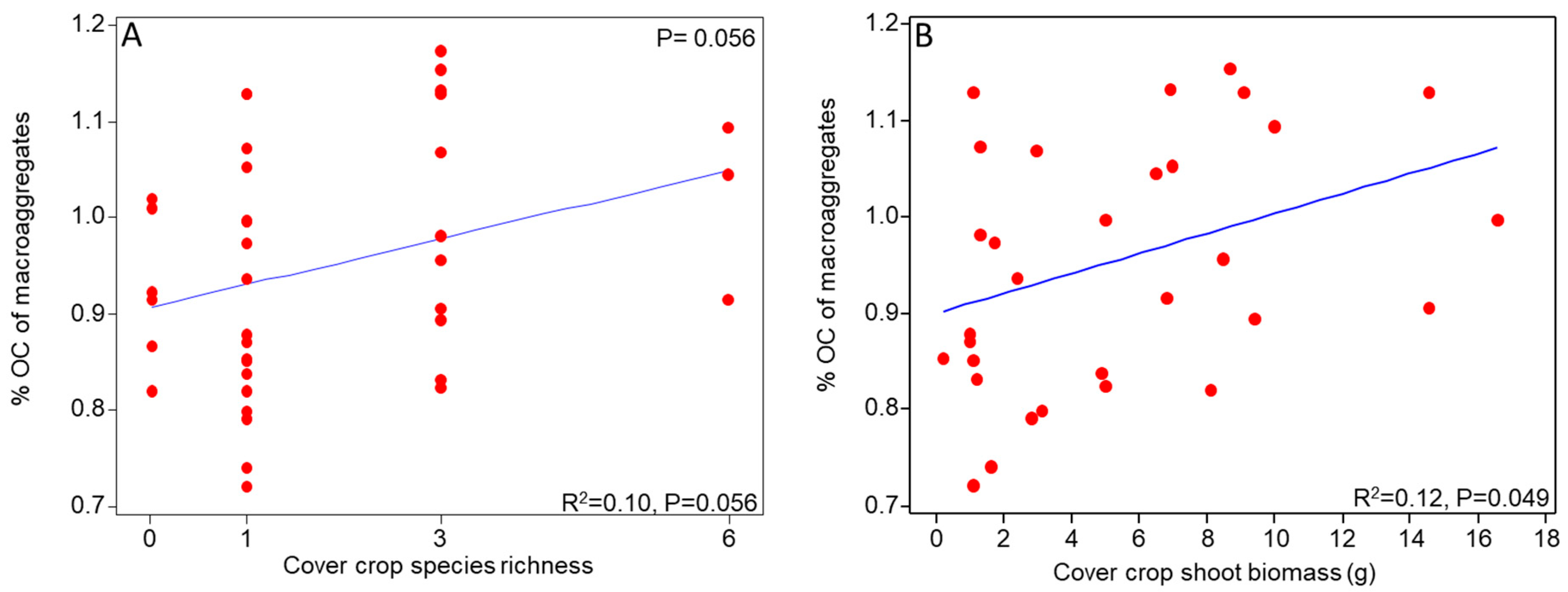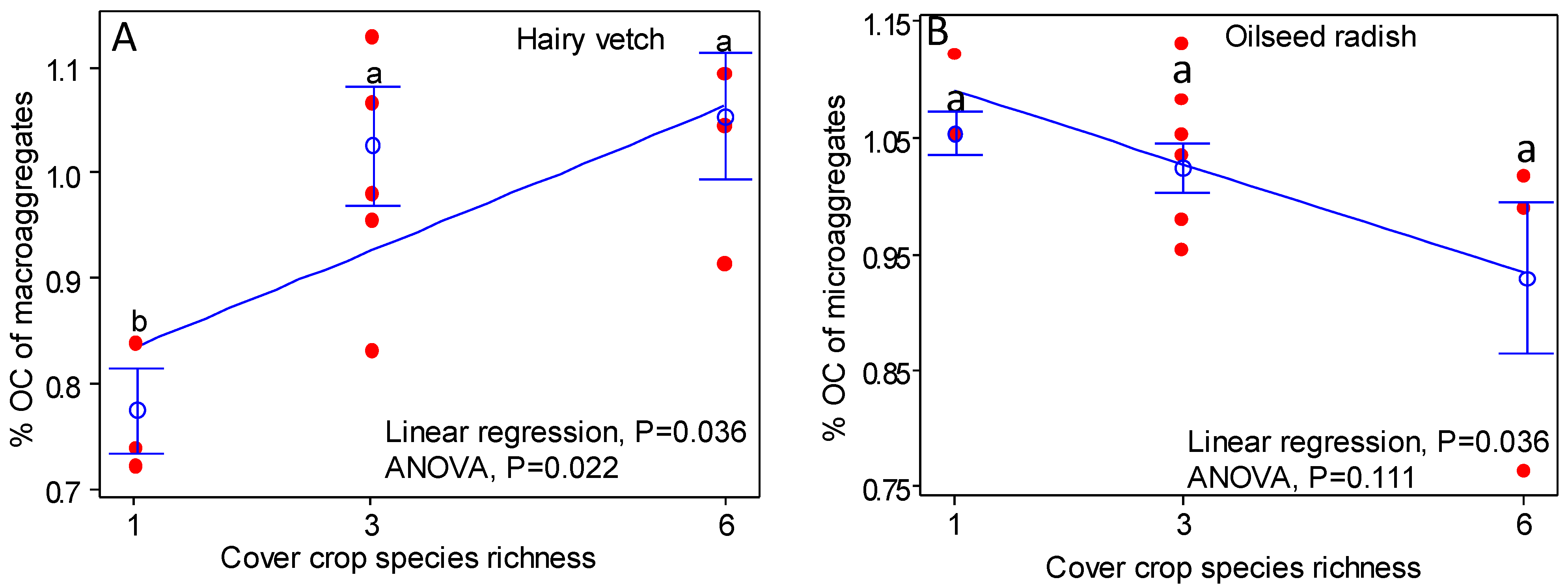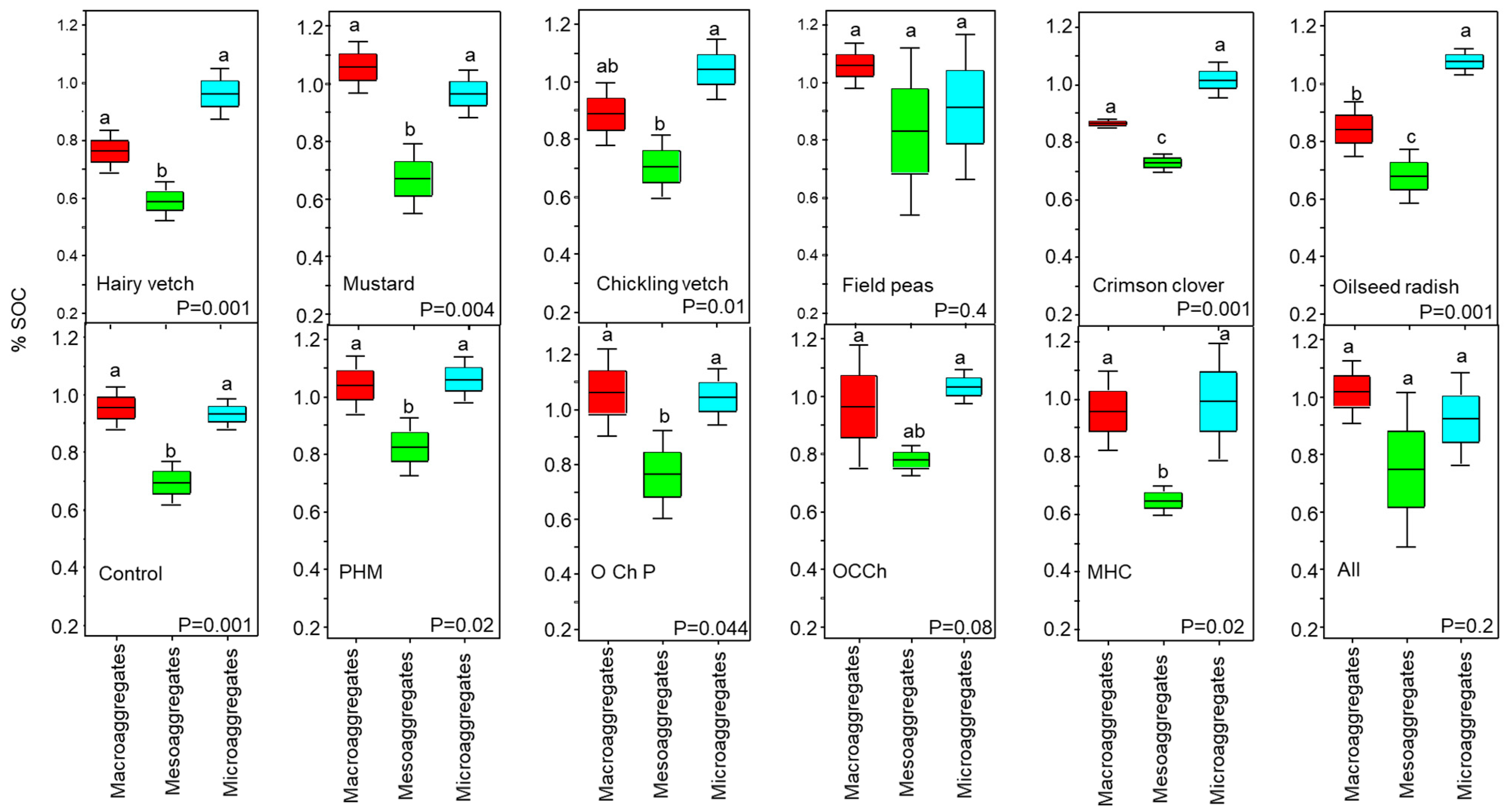Impact of Cover Crop Monocultures and Mixtures on Organic Carbon Contents of Soil Aggregates
Abstract
:1. Introduction
2. Materials and Methods
2.1. Soil and Cover Crop Species
2.2. Experimental Setup and Soil Sampling
3. Data Analysis
4. Results
4.1. Impact of Cover Crop Monocultures and Mixtures on OC Contents of Soil Aggregates
4.2. Impact of Cover Crop Diversity Gradient on OC Contents of Different Soil Aggregate-Size Classes
4.3. Comparing OC Contents among Different Aggregate-Size Classes in Cover Crop Monocultures and Mixture Treatments
5. Discussion
6. Conclusions and Limitations
Author Contributions
Funding
Institutional Review Board Statement
Informed Consent Statement
Data Availability Statement
Acknowledgments
Conflicts of Interest
References
- Blanco-Canqui, H.; Shaver, T.M.; Lindquist, J.L.; Shapiro, C.A.; Elmore, R.W.; Francis, C.A.; Hergert, G.W. Cover Crops and Ecosystem Services: Insights from Studies in Temperate Soils. Agron. J. 2015, 107, 2449–2474. [Google Scholar] [CrossRef] [Green Version]
- Kaye, J.P.; Quemada, M. Using Cover Crops to Mitigate and Adapt to Climate Change. A Review. Agron. Sustain. Dev. 2017, 37, 4. [Google Scholar] [CrossRef]
- Pervaiz, Z.H.; Iqbal, J.; Zhang, Q.; Chen, D.; Wei, H.; Saleem, M. Continuous Cropping Alters Multiple Biotic and Abiotic Indicators of Soil Health. Soil Syst. 2020, 4, 59. [Google Scholar] [CrossRef]
- Saleem, M.; Pervaiz, Z.H.; Contreras, J.; Lindenberger, J.H.; Hupp, B.M.; Chen, D.; Zhang, Q.; Wang, C.; Iqbal, J.; Twigg, P. Cover Crop Diversity Improves Multiple Soil Properties via Altering Root Architectural Traits. Rhizosphere 2020, 16, 100248. [Google Scholar] [CrossRef]
- Udom, B.E.; Omovbude, S. Soil Physical Properties and Carbon/Nitrogen Relationships in Stable Aggregates under Legume and Grass Fallow. Acta Ecol. Sin. 2019, 39, 56–62. [Google Scholar] [CrossRef]
- Bolinder, M.A.; Crotty, F.; Elsen, A.; Frac, M.; Kismányoky, T.; Lipiec, J.; Tits, M.; Tóth, Z.; Kätterer, T. The Effect of Crop Residues, Cover Crops, Manures and Nitrogen Fertilization on Soil Organic Carbon Changes in Agroecosystems: A Synthesis of Reviews. Mitig. Adapt. Strateg. Glob. Chang. 2020, 25, 929–952. [Google Scholar] [CrossRef]
- Ball, K.R.; Baldock, J.A.; Penfold, C.; Power, S.A.; Woodin, S.J.; Smith, P.; Pendall, E. Soil Organic Carbon and Nitrogen Pools Are Increased by Mixed Grass and Legume Cover Crops in Vineyard Agroecosystems: Detecting Short-Term Management Effects Using Infrared Spectroscopy. Geoderma 2020, 379, 114619. [Google Scholar] [CrossRef]
- Adetunji, A.T.; Ncube, B.; Mulidzi, R.; Lewu, F.B. Management Impact and Benefit of Cover Crops on Soil Quality: A Review. Soil Tillage Res. 2020, 204, 104717. [Google Scholar] [CrossRef]
- Haruna, S.I.; Anderson, S.H.; Udawatta, R.P.; Gantzer, C.J.; Phillips, N.C.; Cui, S.; Gao, Y. Improving Soil Physical Properties through the Use of Cover Crops: A Review. Agrosystems Geosci. Environ. 2020, 3, e20105. [Google Scholar] [CrossRef]
- Thorup-Kristensen, K.; Magid, J.; Jensen, L.S. Catch Crops and Green Manures as Biological Tools in Nitrogen Management in Temperate Zones; Elsevier: Amsterdam, The Netherlands, 2003; pp. 227–302. [Google Scholar]
- Blanco-Canqui, H.; Mikha, M.M.; Presley, D.R.; Claassen, M.M. Addition of Cover Crops Enhances No-Till Potential for Improving Soil Physical Properties. Soil Sci. Soc. Am. J. 2011, 75, 1471–1482. [Google Scholar] [CrossRef]
- Nouri, A.; Lee, J.; Yin, X.; Tyler, D.D.; Saxton, A.M. Thirty-Four Years of No-Tillage and Cover Crops Improve Soil Quality and Increase Cotton Yield in Alfisols, Southeastern USA. Geoderma 2019, 337, 998–1008. [Google Scholar] [CrossRef]
- Alonso-Ayuso, M.; Gabriel, J.L.; Quemada, M. The Kill Date as a Management Tool for Cover Cropping Success. PLoS ONE 2014, 9, e109587. [Google Scholar] [CrossRef] [PubMed]
- Veloso, M.G.; Cecagno, D.; Bayer, C. Legume Cover Crops under No-Tillage Favor Organomineral Association in Microaggregates and Soil C Accumulation. Soil Tillage Res. 2019, 190, 139–146. [Google Scholar] [CrossRef]
- Powlson, D.S.; Stirling, C.M.; Thierfelder, C.; White, R.P.; Jat, M.L. Does Conservation Agriculture Deliver Climate Change Mitigation through Soil Carbon Sequestration in Tropical Agro-Ecosystems? Agric. Ecosyst. Environ. 2016, 220, 164–174. [Google Scholar] [CrossRef]
- Tisdall, J.M.; Oades, J.M. Organic Matter and Water-Stable Aggregates in Soils. J. Soil Sci. 1982, 33, 141–163. [Google Scholar] [CrossRef]
- Schaefer, M.V.; Bogie, N.A.; Rath, D.; Marklein, A.R.; Garniwan, A.; Haensel, T.; Lin, Y.; Avila, C.C.; Nico, P.S.; Scow, K.M.; et al. Effect of Cover Crop on Carbon Distribution in Size and Density Separated Soil Aggregates. Soil Syst. 2020, 4, 6. [Google Scholar] [CrossRef] [Green Version]
- Blanco-Canqui, H.; Lal, R. Mechanisms of Carbon Sequestration in Soil Aggregates. Crit. Rev. Plant Sci. 2004, 23, 481–504. [Google Scholar] [CrossRef]
- Silva, A.d.N.; de Figueiredo, C.C.; de Carvalho, A.M.; dos Santos Soares, D.; dos Santos, D.C.R.; da Silva, V.G. Effects of Cover Crops on the Physical Protection of Organic Matter and Soil Aggregation. Aust. J. Crop. Sci. 2016, 10, 1623–1629. [Google Scholar] [CrossRef]
- Merry, R.H.; Spouncer, L.R. The Measurement of Carbon in Soils Using a Microprocessor-controlled Resistance Furnace. Commun. Soil Sci. Plant Anal. 1988, 19, 707–720. [Google Scholar] [CrossRef]
- Massey, M.S.; Davis, J.G.; Ippolito, J.A.; Sheffield, R.E. Effectiveness of Recovered Magnesium Phosphates as Fertilizers in Neutral and Slightly Alkaline Soils. Agron. J. 2009, 101, 323–329. [Google Scholar] [CrossRef]
- Rosenzweig, S.T.; Fonte, S.J.; Schipanski, M.E. Intensifying Rotations Increases Soil Carbon, Fungi, and Aggregation in Semi-Arid Agroecosystems. Agric. Ecosyst. Environ. 2018, 258, 14–22. [Google Scholar] [CrossRef]
- Amézketa, E. Soil Aggregate Stability: A Review. J. Sustain. Agric. 1999, 14, 83–151. [Google Scholar] [CrossRef]
- Bronick, C.J.; Lal, R. Soil Structure and Management: A Review. Geoderma 2005, 124, 3–22. [Google Scholar] [CrossRef]
- Mustafa, A.; Minggang, X.; Ali Shah, S.A.; Abrar, M.M.; Nan, S.; Baoren, W.; Zejiang, C.; Saeed, Q.; Naveed, M.; Mehmood, K.; et al. Soil Aggregation and Soil Aggregate Stability Regulate Organic Carbon and Nitrogen Storage in a Red Soil of Southern China. J. Environ. Manag. 2020, 270, 110894. [Google Scholar] [CrossRef]
- Moitinho, M.R.; Fernandes, C.; Truber, P.V.; Marcelo, A.V.; Corá, J.E.; da Silva Bicalho, E. Arbuscular Mycorrhizal Fungi and Soil Aggregation in a No-Tillage System with Crop Rotation. J. Plant Nutr. Soil Sci. 2020, 183, 482–491. [Google Scholar] [CrossRef]
- Blaud, A.; van der Zaan, B.; Menon, M.; Lair, G.J.; Zhang, D.; Huber, P.; Schiefer, J.; Blum, W.E.H.; Kitzler, B.; Wei, E.H.; et al. The Abundance of Nitrogen Cycle Genes and Potential Greenhouse Gas Fluxes Depends on Land Use Type and Little on Soil Aggregate Size. Appl. Soil Ecol. 2018, 125, 1–11. [Google Scholar] [CrossRef] [Green Version]
- Mendes, I.C.; Bandick, A.K.; Dick, R.P.; Bottomley, P.J. Microbial Biomass and Activities in Soil Aggregates Affected by Winter Cover Crops. Soil Sci. Soc. Am. J. 1999, 63, 873–881. [Google Scholar] [CrossRef]
- Sarker, J.R.; Singh, B.P.; Cowie, A.L.; Fang, Y.; Collins, D.; Dougherty, W.J.; Singh, B.K. Carbon and Nutrient Mineralisation Dynamics in Aggregate-Size Classes from Different Tillage Systems after Input of Canola and Wheat Residues. Soil Biol. Biochem. 2018, 116, 22–38. [Google Scholar] [CrossRef]
- Lamb, E.G.; Kennedy, N.; Siciliano, S.D. Effects of plant species richness and evenness on soil microbial community diversity and function. Plant Soil 2011, 338, 483–495. [Google Scholar] [CrossRef]
- Sahib, M.R.; Pervaiz, Z.H.; Williams, M.A.; Saleem, M.; DeBolt, S. Rhizobacterial species richness improves sorghum growth and soil nutrient synergism in a nutrient-poor greenhouse soil. Sci. Rep. 2020, 10, 1–13. [Google Scholar] [CrossRef]
- Bonkowski, M.; Roy, J. Soil microbial diversity and soil functioning affect competition among grasses in experimental microcosms. Oecologia 2005, 143, 232–240. [Google Scholar] [CrossRef] [PubMed]
- Hazra, K.K.; Nath, C.P.; Singh, U.; Praharaj, C.S.; Kumar, N.; Singh, S.S.; Singh, N.P. Diversification of Maize-Wheat Cropping System with Legumes and Integrated Nutrient Management Increases Soil Aggregation and Carbon Sequestration. Geoderma 2019, 353, 308–319. [Google Scholar] [CrossRef]
- Zhang, Q.; Li, S.; Saleem, M.; Ali, M.Y.; Xiang, J. Biochar and Earthworms Synergistically Improve Soil Structure, Microbial Abundance, Activities and Pyraclostrobin Degradation. Appl. Soil Ecol. 2021, 168, 104154. [Google Scholar] [CrossRef]
- Ruis, S.J.; Blanco-Canqui, H. Cover Crops Could Offset Crop Residue Removal Effects on Soil Carbon and Other Properties: A Review. Agron. J. 2017, 109, 1785–1805. [Google Scholar] [CrossRef]
- Dozier, I.A.; Behnke, G.D.; Davis, A.S.; Nafziger, E.D.; Villamil, M.B. Tillage and Cover Cropping Effects on Soil Properties and Crop Production in Illinois. Agron. J. 2017, 109, 1261–1270. [Google Scholar] [CrossRef] [Green Version]
- García-González, I.; Hontoria, C.; Gabriel, J.L.; Alonso-Ayuso, M.; Quemada, M. Cover Crops to Mitigate Soil Degradation and Enhance Soil Functionality in Irrigated Land. Geoderma 2018, 322, 81–88. [Google Scholar] [CrossRef]
- Rillig, M.C.; Muller, L.A.; Lehmann, A. Soil Aggregates as Massively Concurrent Evolutionary Incubators. ISME J. 2017, 11, 1943–1948. [Google Scholar] [CrossRef]
- Wang, B.; Brewer, P.E.; Shugart, H.H.; Lerdau, M.T.; Allison, S.D. Soil Aggregates as Biogeochemical Reactors and Implications for Soil–Atmosphere Exchange of Greenhouse Gases—A Concept. Glob. Chang. Biol. 2019, 25, 373–385. [Google Scholar] [CrossRef]




| Sr. | Combinations | Abbreviation | Treatment Type |
|---|---|---|---|
| 1. | Control | C | Un-planted |
| 2. | Crimson clover | CC | Monoculture |
| 3. | Chickling vetch | Ch | Monoculture |
| 4. | Field peas | P | Monoculture |
| 5. | Hairy vetch | H | Monoculture |
| 6. | Mighty mustard | M | Monoculture |
| 7. | Oilseed radish | O | Monoculture |
| 8. | Field peas + Hairy vetch + Mustard | PHM | Three-species mixture |
| 9. | Mustard +Hairy vetch + Crimson clover | MHC | Three-species mixture |
| 10. | Oilseed radish + Crimson clover + Chickling vetch | OCCh | Three-species mixture |
| 11. | Oilseed radish + Chickling vetch + Field peas | OChP | Three-species mixture |
| 12. | All species mixture | All | 6-species mixture |
Publisher’s Note: MDPI stays neutral with regard to jurisdictional claims in published maps and institutional affiliations. |
© 2021 by the authors. Licensee MDPI, Basel, Switzerland. This article is an open access article distributed under the terms and conditions of the Creative Commons Attribution (CC BY) license (https://creativecommons.org/licenses/by/4.0/).
Share and Cite
Topps, D.; Khabir, M.I.u.; Abdelmagid, H.; Jackson, T.; Iqbal, J.; Robertson, B.K.; Pervaiz, Z.H.; Saleem, M. Impact of Cover Crop Monocultures and Mixtures on Organic Carbon Contents of Soil Aggregates. Soil Syst. 2021, 5, 43. https://doi.org/10.3390/soilsystems5030043
Topps D, Khabir MIu, Abdelmagid H, Jackson T, Iqbal J, Robertson BK, Pervaiz ZH, Saleem M. Impact of Cover Crop Monocultures and Mixtures on Organic Carbon Contents of Soil Aggregates. Soil Systems. 2021; 5(3):43. https://doi.org/10.3390/soilsystems5030043
Chicago/Turabian StyleTopps, Daphne, Md Imam ul Khabir, Hagir Abdelmagid, Todd Jackson, Javed Iqbal, Boakai K. Robertson, Zahida Hassan Pervaiz, and Muhammad Saleem. 2021. "Impact of Cover Crop Monocultures and Mixtures on Organic Carbon Contents of Soil Aggregates" Soil Systems 5, no. 3: 43. https://doi.org/10.3390/soilsystems5030043
APA StyleTopps, D., Khabir, M. I. u., Abdelmagid, H., Jackson, T., Iqbal, J., Robertson, B. K., Pervaiz, Z. H., & Saleem, M. (2021). Impact of Cover Crop Monocultures and Mixtures on Organic Carbon Contents of Soil Aggregates. Soil Systems, 5(3), 43. https://doi.org/10.3390/soilsystems5030043






